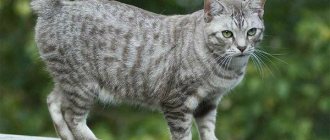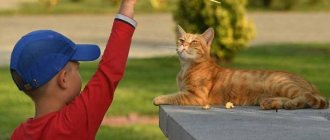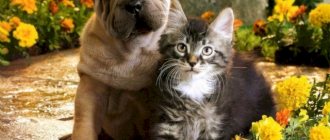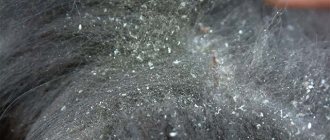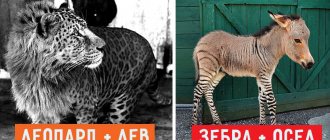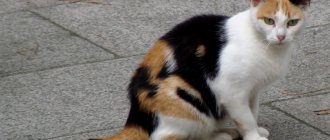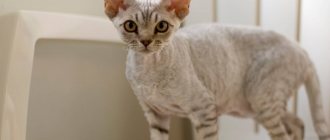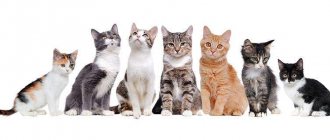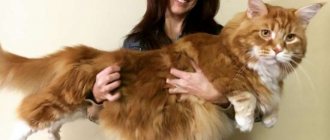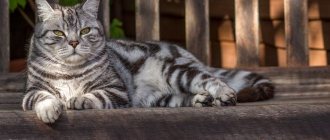A cat is a proud, independent animal, tamed by man, who has become his friend and family pet. A domestic cat is a member of the family for many years, and after a period of “breaking in”, it knows the owner’s character well. The four-legged pet is considered the most popular among other pets. A cat not only brings joy to a person’s life, but also hunts rodents.
Origin and distribution
The forest and steppe subspecies of wild cats were the ancestors of the domestic pet. It is known that the pet began to live with humans about 7 thousand years ago. They were first domesticated by the Egyptians and began to be revered as a sacred animal. Death punishment overtook the cat's killer. And if a furry creature died a natural death in the family, then the ancient Egyptians shaved off their eyebrows as a sign of grief. Burial took place in special cemeteries and in coffins. Being close to people in more comfortable conditions than in nature, the cats gradually lost the pronounced aggressiveness of the predator.
Later, furry beauties inhabited Greece and Rome. The sailors took them on board and thus spread them throughout the Mediterranean, and from there further to Europe and China. By being useful in the fight against rodents, cats have also conquered the human soul. However, in Europe they had to survive. Poor owners of dark fur were tortured and burned. They were considered harbingers of misfortune and the forces of evil.
Types of cats: description
Such pets may have long fur.
According to statistics, the domestic cat species makes up the majority of all its relatives (the population is about 90%), in contrast to purebred specimens (they make up only 2-10%). The name allows us to summarize all varieties of pets that do not fit the scientific description of breeds. An ordinary cat is classified by length, type and color of coat, and size. There are long-haired and short-haired, curly and hairless, large and dwarf. The shape and length of the tail and ears are important: tailless (Manx) and bobtails.
The description of a cat depends on its habitat. Thus, the northern varieties are large, muscular, with thick hair. Southern mongrel cats are short-haired, without undercoat, graceful and graceful. Inhabitants of western latitudes can boast of a natural blue tint of fur, but the characteristics of color variations often come down to brindle, red, 2 or 3 colors. The scientific community has not been able to reach a consensus on the origin, classification and abundance of the species.
Felinology
Felinology is a branch of zoology that studies the anatomy and physiology of domestic cats, as well as their breeds, features of their selection, breeding and maintenance.
What kind of cats exist, you can look at cats, with a description of breed criteria, in the classifications of international felinological organizations. Currently, the most recognized felinological organization is the WCF (World Cat Federation).
WCF classification , cat breeds are divided into 5 categories:
- Longhair
- Semi-longhaired
- Shorthair
- Siamese-Oriental Shorthair
- Hairless
Longhair
Representatives of the category:
The Persian cat is a breed with very long and very silky hair. This is probably one of the most beautiful cat breeds and is extremely affectionate.
Persian cat
The Himalayan cat , also called the Himmie, is a very beautiful and popular cat breed. The cat's eyes are sparkling blue, its fur is long. They have a calm character. What makes them even more beautiful is that their face looks like they are scared or angry. The Himalayan breed is actually a cross between the Siamese and Persian cats. The Himalayan breed has short legs, round blue eyes, a short nose, full cheeks, small ears with rounded tips, and a long body. Himalayan cats have long hair, especially on the tail. The tail is short and needs daily brushing to keep it frizz-free. The color of Himalayan cats is varied, they can be chocolate, white, cream or black. This breed has one eye color, which is dark blue/bright blue. The Himalayan breed is also an ideal pet as these cats are calm, highly intelligent and very playful.
Himalayan cat
The British Longhair cat is very similar to the British Shorthair, with gray fur, a stocky body and rounded features. The main difference is that the British Longhair has a much longer coat. She has yellow eyes, like her short-haired relative. The character of the British Longhair cat is calm, intelligent, arrogant, non-aggressive, independent. There is a British Fold cat whose character is the same, but this breed is not recognized by the WCF.
British longhair cat
The Scottish Longhair is a medium to large sized cat with strong muscles and a robust build. They have large shoulders, a strong neck and legs that end in round paws. The Scottish Longhair cat has a round head, a short nose, and round and wide-set eyes. The Scottish Longhair's tail is thicker at the base, medium in size and rounded at the tip. The ears are erect and drooping; according to this feature, Scottish cats are straight-eared and fold-eared cats. The Scottish Longhair has an overall impression of softness, emphasized by the shape of its mouth, which appears to curve into a smile.
Scottish fold cat
Scottish long-haired straight-eared cat
Burmese Longhair - They have large eyes, a stocky build and a silky coat. Medium size for cats. The character is friendly. A neat cat gets used to its toilet well. Perhaps these are the best cats for an apartment and children.
Burmese longhair cat
Semi-longhair
Representatives of the category:
The Angora cat is a very beautiful breed, with silver hair of a fine, silky texture, usually longest on the neck, but also long on the tail. Most are white cats, some are yellowish, others are olive, approaching the color of Leo. All of them are gentle creatures with a soft character. This breed of cat has unusual tastes. An Angora cat has been described as liking macaroons. It was reported about an Angora cat who was very fond of gin and water and was very partial to curry. He also ate peas, greens and beans (in moderation). Many Angora cats love asparagus.
Angora cat
Cymric cat - its representatives do not have a tail. For many years, this breed was not considered independent because many experts argued that it was a modified Manx tailless cat, only with long hair.
Cymrik cat
Bengal Longhair , The Bengal cat is the only domestic cat that has the same coloring as a leopard and a jaguar! This breed loves water and loves to walk outdoors, on a leash, with its owners.
Bengal longhair cat
The Maine Coon is a breed of cat that is kind, well-mannered and easily gets along with friendly dogs and children. In size, it is a large, strong and agile cat. When asked which cats are the best at catching mice and rats, we can safely say that the Maine Coon is one of the best. This is a large cat and it can easily cope with even the largest rat. This is a very intelligent and trainable breed.
Maine Coon
- Shorthair
Representatives of the category:
Egyptian Mau breed. The Egyptian Mau's markings, which might be considered more characteristic of wild cats than domestic breeds, are the first to catch the eye, but the beauty of the Mau goes far beyond its coat and beautiful green eyes. One immediately senses the spirit and mystery inherent in the deity she once was in ancient Egypt. The Egyptian Mau is smooth-haired and muscular, which gives the Mau an uncanny ability to jump, a long stride, and makes the breed capable of great speeds. The shoulder blades are high, the legs are long, and the hind legs are longer, giving it the gait of a cheetah. Mau can sit serenely, putting himself in order, and the next moment he will jump without hesitation. A scarab (a beetle considered sacred by the ancient Egyptians) on the forehead and large ears complete the look.
Egyptian Mau
The Chartreuse breed has a bluish-gray coat.
Chartreux cat
Manx cat - she has no tail, only something like a knob, as if her tail was amputated. The color of the coat varies.
Manx cat
The Bengal Shorthair cat is a short-haired variety of the Bengal breed.
Bengal shorthair cat
The British Shorthair is a shorthaired variety of the British cat breed.
British shorthair cat
The Scottish Shorthair cat is a short-haired variety of the Scottish cat breed. It also has two varieties: fold-eared and straight-eared. Scottish straight-eared cat colors with photos and names and short-haired fold.
Scottish fold shorthair cat
Scottish straight-eared shorthair cat
Siamese-Oriental Shorthair
Representatives of the category:
The Siamese cat is the most recognizable cat breed due to its unique coloring, which is a form of partial albinism. Their fur is temperature sensitive. The cooler areas (ears, face, legs and tail) are darker, while the body (warmest part) is lighter. This is why Siamese kittens are born pure white (constant temperature in the womb) and develop their colors as they age.
Siamese cat
An oriental cat , with large pointed ears and a majestic triangular head, this short-haired cat is one of the brightest representatives of the cats.
Oriental cat
Characteristics of a domestic cat: appearance and character
A simple cat distinguishes colors and sees well in the dark. The sense of smell is well developed, not inferior to that of a dog.
The body of the animal is harmoniously developed and on average has a length of about half a meter.
The external characteristics of pets are incredibly diverse, but common features for all can be identified:
- The head is round, somewhat flattened, with erect ears.
- The muzzle is short, wide jaws, sharp teeth. The male differs from the female in having a wider forehead.
- The eyes are expressive, large, slightly rounded. A special feature is the presence of a nictitating membrane, which performs a protective and cleansing function.
- Torso. Proportionally developed, 50-70 cm long.
- The ears are developed and turn towards the sound.
- Whiskers and vibrissae. Helps you navigate the terrain and in the dark.
- Limbs and joints. They are distinguished by flexibility and resourcefulness. The pet can be described as an excellent athlete.
Characteristics of a pet:
- Quite developed intelligence, which facilitates everyday communication.
- Strong attachment to one's home and owner.
- Pride and independence of character. They are difficult to train.
Features of behavior
With the help of hissing, the animal expresses certain emotions.
The sounds produced are meowing, purring, hissing, howling, squeaking. These are all ways to express yourself and attract attention. Tail movements can also tell a lot. A curled or raised tail indicates a friendly disposition, frequent tapping indicates irritation and dissatisfaction, and a twitching tip indicates excitement and interest. In addition, the tail performs steering functions. When falling from a height, an animal always lands on its paws. The cat shows contentment with life by stretching its body, simultaneously releasing its claws and pleasantly purring.
The cat perceives moving objects in the house as prey and begins to “hunt”. While playing with a person, a domestic cat bites the wrist, thinking it is the victim's neck. At the same time, they have an instinct of self-preservation, laid down in ancient times. By moving around the perimeter, rather than directly, they seem to bypass the enemy. During introductions, cats sniff their noses. The lowering of the head of one of them speaks of the peace process and submission.
How many years does a cat live?
What is the life expectancy of cats?
Cats live on average 13-18 years
. Under very favorable conditions, they live up to 20.
There have been many cases recorded on earth where cats lived much longer.
So, on November 5, 1957, the cat Mao (owner A. St. George Moore) died at the age of 34 years. And the cat Puss (owner T. Hollway) lived the longest, who died on November 29, 1939 (the day after his birthday) at the age of 36 years!
There is information that now the oldest cat is considered to be a cat named Lucy. This “old lady” is already 39 years old!
About the health of a mongrel pet
If your pet's nose becomes hot and dry, then he is probably sick with something.
Responsibility for the well-being of a pet lies with the owner. Unusual behavior, attempts to find a secluded place and sit there should alert household members. Suspicions will be confirmed if the cat has a hot, dry nose, drinks a lot, breathes frequently and does not eat. Photophobia and unmotivated aggression are included in the description of rabies. Attentiveness to your pet will not allow you to miss this dangerous disease. It is better not to postpone a visit to the veterinarian, but communication between family members and the cat is limited. Regular brushing, water treatments, and eye and ear hygiene will help keep your cat healthy.
Hairless
Don Sphynx
Don Sphynxes are affectionate, non-aggressive, and playful. They have somewhat dog-like habits, while remaining unobtrusive and tactful.
Breed characteristics
- Hairless cover;
- medium sized body;
- big ears; expressive almond-shaped eyes;
- pronounced eyebrows and cheekbones;
- long graceful paws.
Canadian Sphynx
The Canadian Sphynx is the first recognized breed of hairless cat. All Sphynx cats are characterized by increased body temperature and the ability to tan. They become very attached to their owners. These creatures need constant communication. Canadians are very smart and learn new things easily. They are friendly with absolutely everyone and get along great with children.
Breed characteristics
- Hairless cover;
- dense muscular body;
- folds on the skin;
- the forelimbs are shorter than the hind limbs;
- large wide ears with rounded tips.
Petersburg Sphinx
Of all the types of sphinxes, the Petersburg, or Peterbald, is the most graceful. He looks more like an oriental cat than other sphinxes. The Peterbald is a companion cat; he does not like to walk on his own. Thanks to the presence of Siamese-Oriental cat breeds in the pedigree, the Peterbald is very active. His character retains all the traits characteristic of the ancestors of other breeds: lack of aggression, sociability and love.
Breed characteristics
- Hairless cover;
- thin, invisible undercoat;
- small wedge-shaped head with huge ears;
- blue or green eyes;
- long nose, straight profile.
What to feed?
Cats have well-developed taste buds on their tongue. They distinguish between sour, salty, bitter and sweet.
The food tract of cats is accustomed to meat. Sharp fangs crush it, and the tubercles on the sides of the tongue help separate the pulp from the bones. The meat menu needs to be diversified with other high protein foods - fish, eggs, dairy products. Carbohydrates are needed in small quantities - cereals, vegetables, bread. Eating too much food leads to obesity, and a normal human diet is harmful to a cat. Periodically, the cat's stomach is cleared of undigested residues. To do this, the mustache “snacks” on grass, leaves, and at home – on house plants, for example, aloe. Sometimes the “hunter” eats soil, which indicates a lack of microelements. They are always included in cat food.
